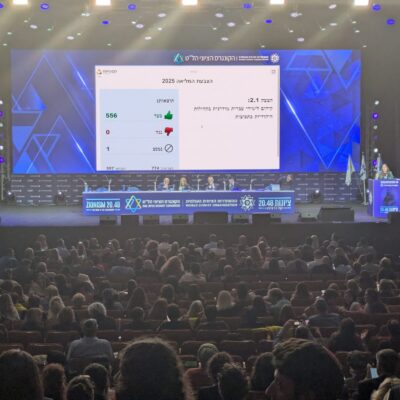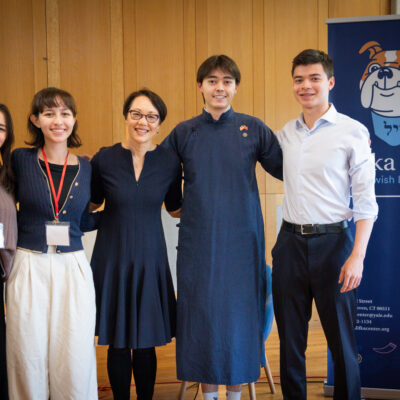The Covid Content Revolution

By Andrés Spokoiny
When my son, a high school senior, decided to take a science course that would look good on his college applications, he initially registered for one offered nearby. But when he discovered that Israel’s legendary Weizmann Institute was offering a science course by Zoom, he cancelled his fine-but-nothing-special course and registered for the Weizmann one which, to my delight, was free of charge.
On the other side of the planet, my mother, who would have spent her Sunday in the decidedly mediocre Museo de Bellas Artes of Buenos Aires, was instead on a virtual tour of Madrid’s Prado Museum, followed by a concert of the Berlin Philharmonic, instead of the local tango ensemble.
Overwhelmed as we are with the threat that Covid presents to our institutions, we tend to forget a quiet revolution that is taking place during the pandemic: the democratization of quality.
If everything is online, and mostly free, why not go for the best? Suddenly, folks who would have gone to a “shiur” in their neighborhood shul can instead listen to Israeli journalist Yossi Klein Halevi or Rabbi Shai Held – dean of New York’s Hadar – via Zoom. You like Los Angeles’ Rabbi Sharon Brous? No problem, you can attend services online for her congregation, IKAR.
If everything is on Zoom anyway, why would you limit yourself to the offerings in your local neighborhood? And there’s a more unsettling corollary of this reality: After my mom got used to the Prado Museum, why would she go back to Bellas Artes? It is like returning to your Chevy after driving a Mercedes, or drinking a $10 Bordeaux after tasting Chateau Margaux 1985.
Of course, it would be an unfair generalization to assume that every local or neighborhood organization produces poor-quality programs; some of them are excellent, homey and warm. But there’s simply a matter of critical mass: Most local synagogues can’t compete with the resources of an international organization, and most local JCCs can’t afford to hire the type of talent now freely available on Zoom. Virtual activities allow for a scale that physical ones don’t. It makes sense to hire an expensive speaker for 1,000 people, but not for 25.
These developments can be a godsend for the Jewish world as a whole. Suddenly, we can dramatically increase the quality of programming everywhere; we can democratize access to the best content and raise the level of knowledge in the community. But they also present undeniable challenges to local and small organizations. If I can listen to whatever rabbi I want, why do I need to pay membership dues in my shul? The distant organization with the star rabbi has a challenge too: Why should the member of a synagogue in San Francisco subsidize somebody who zooms in from Windsor, Ontario? And what happens when I want Rabbi Brous to officiate at a bar mitzvah in Brooklyn? To what extent is her role to serve the community that pays her salary versus to be a resource for the entire Jewish world?
So, the democratization of quality is not just a matter of access to good content, but something that will force a re-examination of communal structures and business models. It may also catalyze a redefinition of the role of many a communal professional.
True, people will look for quality, but they will still need the intimacy of community and personal contact with their rabbis and teachers. My teenage son can listen to Yossi Klein Halevi, but that won’t give him the interaction with peers that he seeks. So maybe, the local rabbinical intern shouldn’t try to compete with a star rabbi, but should use her drash as a jumping-off point for study or interaction within her community. In other words, one can “outsource” the content to the best provider and focus on interaction with that content through meaningful community experiences. In other words, the role of the “Museo de Bellas Artes” is not to compete with the Louvre, but to curate a selection of content from the best museums around the world and help my mom and her friends navigate and interact with that selection. The skill required of that museum’s curator is then different: It’s to create the best group-dynamic, to ask relevant questions and help people as they seek beauty and meaning in works of art. Back to Jewish life: I don’t need my Hebrew school teacher to come up with the best content – that can be found online. What she must do is motivate the children, creating meaningful ways for them to interact with the content and with one another.
Also, as we noted above, the quality revolution forces the rethinking of organizations’ business models and their unique value proposition. It also necessitates a new approach to generating revenue. Could we develop creative membership models? Could we imagine a local synagogue being like a Spotify stream, a platform upon which you can curate and upload the best content from around the Jewish world? How would this be financed? Would this encourage more centralization? Can strategic partnership between organizations offer the best of both worlds?
To put it bluntly but honestly, before Covid, mediocrity was a growing problem in Jewish life. There was excellent content, but it was confined to certain niches and not always accessible to great numbers of Jews. Covid changed that, and also generated a degree of healthy competition. Many local communities were, to a certain extent, like a closed economy in which imports are not allowed and consumers are limited to whatever product the local companies decide to create. Now imports are allowed, and consumers are realizing that Japanese cars are better and cheaper (for those of you old enough to remember the 1980s).
As with so many things, a return to the status quo pre-Covid is not possible, and I would add, not desirable. We all tasted the Chateau Margaux, and want to keep having it, but we still need glasses from which to drink it, cheese to accompany it, and friends with whom to enjoy it.
Funders have an important role to play in all this. They can, for example, fund shared content platforms, subsidize centralized access to high-quality virtual programs, invest in creative thinking regarding the integration of virtual and physical and, in general terms, work with their grantees on new business models that help them capture the best of both worlds.
The combination of the best content, and the best distribution platform can be truly revolutionary – and one good thing that can emerge out of this benighted pandemic.
Andrés Spokoiny is President and CEO of Jewish Funders Network.

 Add EJP on Google
Add EJP on Google









